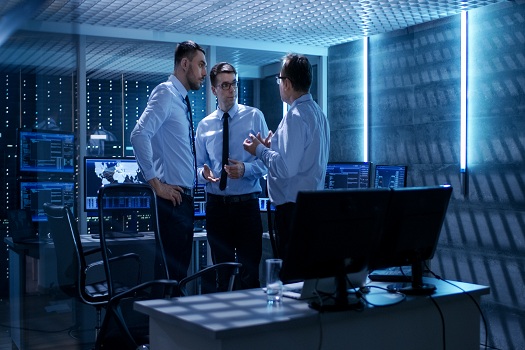Navigating the World of Corporate Security: Secret Insights and Finest Practices
From Cybersecurity to Physical Steps: Reinforcing Corporate Safety in an Altering Globe
By integrating the staminas of both cybersecurity and physical protection, companies can develop an extensive defense strategy that attends to the varied variety of risks they deal with. In this conversation, we will certainly check out the altering risk landscape, the need to integrate cybersecurity and physical safety and security, the implementation of multi-factor authentication procedures, the value of worker awareness and training, and the adjustment of protection procedures for remote workforces. By analyzing these essential locations, we will gain beneficial understandings into how companies can enhance their business safety and security in an ever-changing world.
Recognizing the Altering Risk Landscape
The evolving nature of the modern-day world necessitates a comprehensive understanding of the altering risk landscape for effective company protection. In today's digital and interconnected age, hazards to corporate security have actually become extra intricate and innovative. As innovation advances and organizations come to be significantly reliant on digital framework, the possibility for cyberattacks, information breaches, and other protection breaches has actually substantially increased. It is critical for organizations to stay educated and adapt their safety gauges to resolve these progressing threats.
One key element of understanding the transforming threat landscape is recognizing the various sorts of threats that organizations encounter. Cybercriminals are continuously establishing brand-new strategies to exploit vulnerabilities in computer systems and networks. These risks can range from malware and ransomware strikes to phishing scams and social engineering strategies. Additionally, physical risks such as burglary, criminal damage, and company reconnaissance stay widespread problems for businesses.
Surveillance and evaluating the risk landscape is vital in order to identify possible dangers and vulnerabilities. This involves staying updated on the most recent cybersecurity trends, assessing hazard knowledge reports, and conducting normal threat analyses. By comprehending the changing danger landscape, companies can proactively apply suitable security actions to alleviate risks and protect their properties, credibility, and stakeholders.
Integrating Cybersecurity and Physical Safety And Security
Incorporating cybersecurity and physical safety is essential for comprehensive corporate security in today's electronic and interconnected landscape. As organizations progressively rely on innovation and interconnected systems, the boundaries between physical and cyber risks are becoming blurred. To effectively secure against these threats, an alternative strategy that combines both cybersecurity and physical protection steps is essential.
Cybersecurity concentrates on protecting electronic assets, such as information, networks, and systems, from unauthorized gain access to, disturbance, and burglary. Physical protection, on the other hand, includes actions to protect physical properties, people, and facilities from hazards and vulnerabilities. By incorporating these 2 domain names, organizations can attend to susceptabilities and hazards from both digital and physical angles, therefore enhancing their overall protection position.
The integration of these two techniques allows for a more extensive understanding of safety dangers and allows a unified feedback to incidents. Physical accessibility controls can be boosted by incorporating them with cybersecurity methods, such as two-factor authentication or biometric recognition. Similarly, cybersecurity actions can be enhanced by physical security steps, such as surveillance electronic cameras, alarm systems, and safe accessibility factors.

Executing Multi-Factor Authentication Actions
As organizations progressively prioritize detailed protection steps, one reliable approach is the application of multi-factor verification procedures. Multi-factor verification (MFA) is a safety and security approach that requires customers to provide multiple types of recognition to access a system or application. This technique includes an added layer of protection by integrating something the customer knows, such as a password, with something they have, like a security or a fingerprint token.
By applying MFA, organizations can considerably improve their protection posture - corporate security. Conventional password-based verification has its restrictions, as passwords can be quickly endangered or forgotten. MFA reduces these risks by adding an additional verification variable, making it harder for unapproved individuals to get to sensitive info
There are a number of sorts of multi-factor authentication methods available, including biometric authentication, SMS-based verification codes, and equipment tokens. Organizations need to analyze their specific requirements and pick one of the most proper MFA solution for their requirements.
However, the implementation of MFA need to be very carefully prepared and executed. It is essential to strike an equilibrium in between safety and security navigate here and functionality to avoid user frustration and resistance. Organizations must additionally think about possible compatibility concerns and supply appropriate training and support to guarantee a smooth transition.
Enhancing Staff Member Understanding and Training
To enhance company safety and security, companies need to prioritize improving staff member recognition and training. Many safety and security violations take place due to human mistake or see this website absence of awareness.
Reliable employee awareness and training programs ought to cover a broad array of topics, including data protection, phishing attacks, social engineering, password health, and physical protection actions. These programs should be tailored to the particular requirements and obligations of various employee roles within the organization. Regular training simulations, workshops, and sessions can help workers establish the required skills and expertise to respond and identify to security hazards effectively.
Furthermore, organizations ought to encourage a society of safety awareness and give recurring updates and suggestions to keep staff members notified about the current threats and reduction methods. This can be done via internal communication networks, such as newsletters, intranet websites, and e-mail campaigns. By promoting a security-conscious workforce, companies can considerably minimize the chance of safety incidents and shield their valuable possessions from unauthorized gain access to or compromise.

Adapting Security Procedures for Remote Labor Force
Adapting business protection measures to accommodate a remote workforce is necessary in making certain the protection of sensitive info and possessions (corporate security). With the boosting trend of remote work, organizations should carry out proper security measures to reduce the risks related to this new means of working
One essential aspect of adapting security steps for remote job is establishing safe communication channels. Encrypted messaging platforms and online personal networks (VPNs) can help protect delicate details and stop unapproved gain access to. Furthermore, organizations should impose making use of strong passwords and multi-factor verification to improve the safety and security of remote gain access to.
One more essential consideration is the application of safe and secure remote access services. This involves supplying staff members with protected accessibility to business sources and information through online desktop facilities (VDI), remote desktop methods (RDP), or cloud-based options. These innovations ensure that delicate info continues to be secured while enabling staff members to do their roles efficiently.

Lastly, extensive safety awareness training is important for remote staff members. Educating sessions should cover best techniques for securely accessing and handling sensitive info, determining and reporting phishing efforts, and keeping the total cybersecurity health.
Verdict
In conclusion, as the threat landscape proceeds to evolve, it is important for organizations to enhance their safety and security measures both in the cyber and physical domains. Integrating cybersecurity and physical safety and security, executing multi-factor authentication steps, and boosting employee recognition and training are essential actions in the direction of achieving robust corporate security. In addition, adjusting safety measures to suit remote labor forces is imperative in today's transforming globe. By applying these steps, organizations can mitigate threats and secure their useful assets from prospective threats.
In this discussion, we will certainly explore the transforming risk landscape, the demand to integrate cybersecurity and physical security, the application of multi-factor authentication measures, the relevance of worker recognition and training, and the adaptation of safety steps for remote workforces. Cybersecurity measures can be matched by physical protection steps, such as monitoring video cameras, alarm systems, and secure gain access to factors.
As companies increasingly prioritize thorough security steps, one reliable technique is the implementation of multi-factor authentication procedures.In verdict, as the risk landscape continues to develop, it is vital for organizations to strengthen their safety gauges both in the cyber and physical domain names. Integrating cybersecurity and physical safety and security, carrying out multi-factor verification measures, and improving employee understanding and training are crucial actions in the direction of achieving robust business protection.